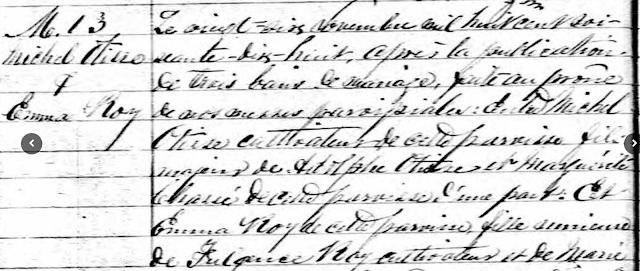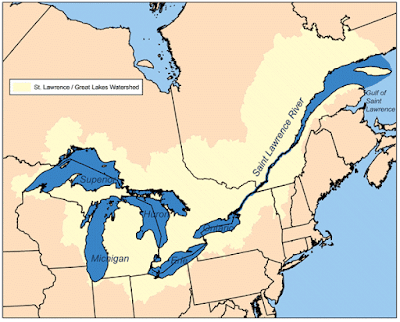Today I'm going to blog about using the Drouin Collection, U.S. and French Catholic Church Record from 1695-1954. All of the examples I am using are from Ancestry.com. I've used these records a lot in the search of my French-Canadian ancestors. These records were written by the parish priests and are hand-written in french. Sometimes this makes it quite difficult to decipher these records. Most of the time I have to use my sleuthing skills by looking at the records previous to and after the record I am trying to decipher. If I get really stuck, I sometimes use Google Translate to help me figure out what words I don't understand. And this can be hard when you have to guess what the letters of some words are.
Here is an example of a decent record. It's fairly easy to read with good handwriting and clear wording:
Ancestry.com
This is the record of the marriage of Michel Otisse and Emma Roy. They are my great-grandparents. I like that this record is signed by both Emma and Michel.
Here is a closeup of the first part of the record:
Their names are on the left ~ Michel Otisse and Emma Roy.
The date is next <Le vingt-six Novembre mil huit cent soixante-dix-huit> the 26th of November 1878. Most records are worded in pretty much the same way. This record states some of that legalese and then continues with his name and <cultivateur> farmer, that he is the oldest son of Adophe Otisse and Marguerite Chassé. Then it continues with Emma and her parents. It's all pretty straight forward. If I was having trouble with the date, I might check the previous record to see the year and month, knowing that the day for this record would be later.
So today I would like to share with you the hardest record to read I have ever come across in the Drouin Collection. It is the record for the death and burial of Jean-Baptiste Otisse. (My previous blog spotlighted his first wife, Cécile Poulin.) He is my sixth great-grandfather. He was born in Dover, New Hampshire and was taken by the Abenaki Indians to Canada and sold into slavery in 1689, when he was just nine years old.
Here is the record of his death and burial in 1760.
Now, at first glance, I figured that I would not be able to glean any information from this record, but as I began working with it and using other records to confirm, it began to come together. The transcription gives the year as 1760 (at the top) in Baie-St-Paul. Let's take each record on the page individually. I'm covering the four records on the left page only. My ancestors record is the third one down on that page.
With the first record, we have the <enterrement> burial of Constance Tremblay on <le 10 Septembre 1760>. Now, this parish priest gives us a special treat of listing the date with the names in the margin. Most priests did not do this. And the year in the record is written out in words, not with numbers, as it was with the first example I gave with Michel Otisse. With this record, having those dates, especially with numbers in the margin really helped with deciphering. This priest also makes his esses with a swooping letter that looks something like a cursive f to me. I have seen this before so when I came across them, I knew them to be esses and not f's.
The next record is a <baptême> baptism dated <14 Sbre 1760> 14 Sep 1760. This can be seen in the margin.
The last record on the page is also a <baptême> baptism for Marie-Rose Fortin dated <le 18 Sbre 1760> 18 Sep 1760. At first, I only saw Fortin in small letters, but thought the first name might be Rose. Then I saw the Marie above it and looked in the text and it looked more like Marie Rose Fortin in the text to me.
Now we come to the record of my ancestor Jean-Baptiste Otisse. He was born to British parents as John Otis. When he came to Québec he was baptized in the Catholic Church as Jean-Baptiste. Otis when pronounced by the french became Otisse or O-teese with the s pronounced softly, not a hard s that sounds like a z. This caused lots of spelling problems and it was sometimes spelled Otice, Otise, Otisse, and Othys. This parish priest spelled his name Otice and you can see it in the margin. <enterrement> Burial of Jean Otice. The date is not super clear, <16 Sbre 1760> the six wasn't clear, but other records (Tanguay, see below) do show his death date as 16 Sep 1760, and since the previous record on this page is 14 Sep and the record after is 18 Sep, I think we can assume that 16 Sep is correct. I was able to decipher the words <l'an> year and then the date written out <mil sept cent soixante seize de Septembre> 1760 16 September. There's not much else here that I could read, but I did find <mort aujourd'hui> died this day, which means his death and burial dates are the same.
Edit: 9.24.24 A comment from a user shows that I am incorrect with <mort Aujourd'ui>. The text actually reads:
Sur la 4ième ligne, il est incrit ´´mort le jour d’auparavant’´ donc le 15 septembre.
b in the Tanguay Collection means christening date, m means marriage date, and s means the burial date.
So there you have it, a successful deciphering of an incredibly illegible record from the Drouin Collection. (And sometimes we still don't get it right.) You can see why I love the Tanguay Collection so much, it's so much easier to read. 😌





















